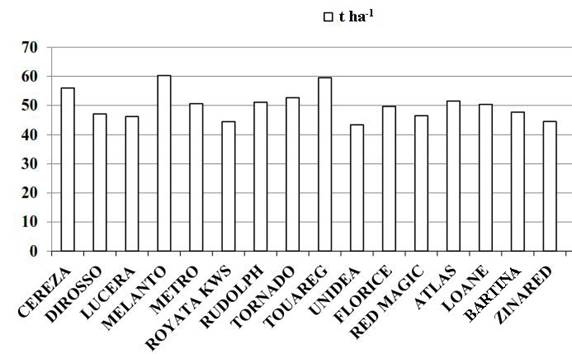My SciELO
Services on Demand
Article
Indicators
-
 Cited by SciELO
Cited by SciELO
Related links
-
 Similars in
SciELO
Similars in
SciELO
Share
Cultivos Tropicales
On-line version ISSN 1819-4087
cultrop vol.41 no.3 La Habana July.-Sept. 2020 Epub Sep 01, 2020
Original article
Use of the Mother-Baby design in the selection of foreign potato cultivars (Solanum tuberosum L.) in Cuba
1Instituto Nacional de Ciencias Agrícolas (INCA), carretera San José-Tapaste, km 3½, Gaveta Postal 1, San José de las Lajas, Mayabeque, Cuba. CP 32 700
2Ministerio de la Agricultura. Conill, La Habana, Cuba
The aim of this assay performed at the National Institute of Agricultural Sciences (INCA) was to use the Mother-Baby methodology in the participatory selection of potato cultivars and to evaluate selection criteria taking account the point of view gender. 74 cultivars were planted in a randomized block design (mother trial) replicated three times in the INCA and in observation plots without replicas in three other production farms. The characterization of the cultivars in the Mother-Baby trial was based on quantitative and qualitative traits, a frequency analysis was carried out for the qualitative ones, and an analysis of variance of a factor and a test of comparison of means, for the quantitative ones by means Duncan´s Test (p≤0.05). The data in the Baby plots were processed through a descriptive statistical analysis, using the IBM SPSS version 21.0 package while the selection criteria carry out for female and male farmers was evaluated through Chi-square test of comparison of proportions. The result showed a great diversity of the quantitative and qualitative traits. From 74 potato cultivars, 41 were selected by the majority of the votes, however, the correspondence of selected cultivars was 15: “Loane”, “Amany”,”Zinared”, “Dirosso”, “Tornado”, “Daifla”, “Touareg”, “Atlas”, “Manitou”, “Arizona”, “Cimega”, “Margarita”, “Rudolph”, “Melanto” y “Faluka” when analyzing their behavior in general in the trials and selections practiced by female and male farmers and plant breeders. Regarding selection criteria carry out for men and women the analysis revealed valuable but different criteria between female and male farmers.On the other hand, valued but different criteria were revealed when considering gender selection.
Key words: breeding; yield; gender; farms; germplasm
INTRODUCTION
Globally, during the decades 2000 and 2010 they have been characterized by a greater integration of participatory evaluation methods in technological development, innovation and in crop improvement programs 1. Using the Participatory Variety Selection or Cultivars (SPC), farmers as intermediaries or end users of technology, participate from the beginning in the evaluation of diversity in breeding programs. The participation of farmers, consumers, the private sector and other stakeholders in the SPC is essential because it enriches selection processes by taking into account preferences, perspectives and multiple selection criteria in settings from different contexts and socio-economic settings 2.
In Cuba, the selection of cultivars practiced by farmers based on their own criteria, known as participatory variety selection (SPV), has been gaining marked interest in the Cuban agricultural field 3. The Cuban Participatory Plant Breeding project, currently the Local Agricultural Innovation Project through the SPC with the participation of thousands of actors, has enabled many farmers to adopt a variety of cultivars and crops on their farms.
The SPC methodology under the “Mom-Baby” (M-B) design has been by numerous research centers used and modified, such as the International Potato Center (CIP); Institute of Innovation and Applied Technology (IITA); International Rice Institute (IRRI) and the International Maize and Wheat Improvement Center (CIMMYT) 4.
In potato cultivation since 2000, the National Institute of Agricultural Sciences (INCA), through strategic support for various projects from donors and the Cuban Ministry of Agriculture, among others, has applied and adapted versions of the methodology of the SPC. Applying the “M-B” design as tools to analyze these assays allows us the methodically process the evaluations, selection and release of SPC cultivars in a relevant way in less time.
The methodology can implement the standard evaluation procedures required for formal cultivar releases, as well as shorten the cultivar introduction time in commercial production.
The objective of this trial was to use the Mom-Baby methodology in the participatory selection of potato cultivars in Cuba.
MATERIALS AND METHODS
The experiments were carried out in four locations: National Institute of Agricultural Sciences (INCA) in the Mayabeque province, in the UBPC “El Violento” also located in Mayabeque, in the Company of Various Crops (ECV) “Horquita” in the province of Cienfuegos and the “La Cuba” Various Crops Company, Ciego Ávila province.
The potato cultivars (Solanum tuberosum L.) used in the present study are of European origin of recent introductions 5, shown in Table 1.
Table 1 Potato cultivars used in the trials
| Nu | Cultivar | Nu | Cultivar | Nu | Cultivar | Nu | Cultivar |
|---|---|---|---|---|---|---|---|
| 1 | ATLAS (Control) | 20 | RUDOLPH | 39 | KIN 04-18 | 58 | PASSION |
| 2 | FLORICE | 21 | RANOMI | 40 | FARIDA | 59 | FERRARI |
| 3 | RED MAGIC | 22 | VOGUE | 41 | SAGITTA | 60 | GAZELLE |
| 4 | AUREA | 23 | CONSTANCE | 42 | PANAMERA | 61 | LUCERA |
| 5 | LOANE | 24 | AR05-08-88 | 43 | RED SCARLETT | 62 | LUNA ROSA |
| 6 | YONA | 25 | TORNADO | 44 | ESSENZA | 63 | RED BULL |
| 7 | NOHA | 26 | CRISTINA | 45 | EL MUNDO | 64 | ROMANTICA |
| 8 | DAIFLA | 27 | TE06-02-01 | 46 | ROYATA KWS | 65 | CIMEGA |
| 9 | EDONY | 28 | ELECTRA | 47 | ZINARED | 66 | FOLVA |
| 10 | AMANY | 29 | FORTUS | 48 | DIROSSO | 67 | FADO |
| 11 | TILBURY | 30 | ASTERIX | 49 | MELANTO | 68 | UNIDEA |
| 12 | G07TT192007 | 31 | HERACLEA | 50 | ELATA KWS | 69 | GOLDEN QUEEN |
| 13 | SURYA | 32 | VICTORIA | 51 | ACTRICE | 70 | HERMES |
| 14 | 658-06-02 | 33 | BIC-05-9 | 52 | CEREZA | 71 | TAISIYA |
| 15 | 15. 07-16-3 | 34 | SPUNTA (Control) | 53 | MARGARITA | 72 | CONNECT |
| 16 | VED2005-076-002 | 35 | HZD 07-289 | 54 | DIDO | 73 | FORZA |
| 17 | ARIZONA | 36 | CHALLENGER | 55 | METRO | 74 | ROMANO (Control) |
| 18 | FALUKA | 37 | ROSI | 56 | TOUAREG | ||
| 19 | MANITOU | 38 | TAURUS | 57 | CRESCENDO |
The planting date corresponded to December 12, 15, 17 and 20 respectively during the 2016-2017 agricultural season.
In the INCA area, the 74 cultivars were distributed in six trials (Mom Design), where the dimensions of the plots were five meters long and seven rows were 0.90 m apart. The structure of the design was in completely random blocks replicated three times; on a uniform, Ferralitic Red leached eutric soil 6. Cultural work, fertilization, irrigation and phytosanitary protection were carried out according to the Technical Instructions for cultivation 7.
In the farms that were the baby trials 1 the size of the plots were the same dimensions as those of INCA.
The characterization of the Mom-Baby trial was based on quantitative and qualitative characters of the 74 accessions 8. The evaluation unit consisted of the two central rows of 19 plants each, after eliminating the edge effect of each of the plots. The data of the agronomic variables were recorded as the total number of tubers per plant (total number of tubers among the number of plants); the total yield per plant (mass of tubers between plant numbers) that was later expressed in yield per hectare t ha-1 (total yield per plant x 44444 plants/1000). Another variables were also studied, such as the average tuber mass in kg (that is the total tuber mass per plant among the total number of tubers per plant); the skin color of the tuber (pink, red, yellow); tuber shape (round, oval, elongated, oblong) and depth of the eyes of the tubercles (superficial, medium and deep). In addition, the affectation in the tubercle by Streptomyces scabies (common scabies) according to the scale of 6 degrees were studied 9.
Qualitative character analysis
For the qualitative characters skin color of the tuber, shape of the tuber and depth of the eyes of the tubers, a frequency analysis was performed using the IBM SPSS version 21.0 package 10.
Analysis of the quantitative characters
In the case of the quantitative characters evaluated in the Mom Design, a one-way analysis of variance (ANOVA) and a mean comparison test were performed using the Duncan test (p≤0.05). The data in the Baby plots were processed through descriptive statistical analysis, using the IBM SPSS version 21.0 package 10.
Selection criteria analysis
The different selection criteria differentiated by men and by women were, for in the voting form, collected and accounted. Their percentage was calculated to determine the differences between the treatments through the chi-square test of comparison of proportions at 0.05 significance for independent samples.
RESULTS AND DISCUSSION
When evaluating the qualitative characteristics from the frequency analyzes carried out, it was observed that in the 74 cultivars evaluated, the yellow color of the skin of the tubers was the most outstanding (75 %), while the red color was observed in 15 % and the pink color by 10 % within them (Figure 1).
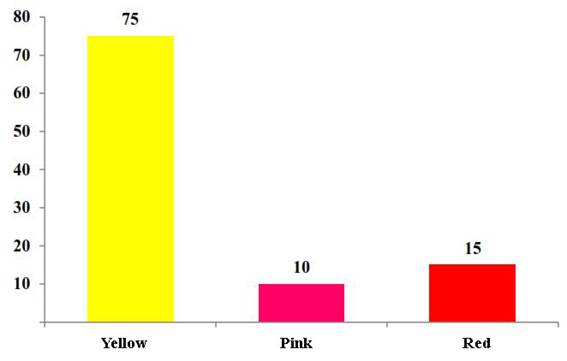
Figure 1 Graphical representation of the frequencies observed for the color character of the tuber skin in the cultivars examined
The presence of these colors of tubers in potato cultivars and other crops may be due to the selection made by plant breeders in other improvement programs 11 in accordance with the demands of the market in question, these results could be possible due to greater existence of cultivars with yellow skin in germplasms. On the other hand, the inheritance of the main qualitative and quantitative characters in potatoes has been investigated for more than 100 years. Despite this, the inheritance of these characters has not been clearly defined, possibly due to the heterozygous nature of autotetraploids.
Some authors have worked with tetraploid potatoes (Solanum tuberosum L.) identified 3 loci 11: D, R and P responsible for the skin color of the tubers. The R allele controls the synthesis of red anthocyanin, the P allele of purple anthocyanin, and the D allele was required for the accumulation of anthocyanins in the skin.
In the case of the tuber shape, the most predominant was the oblong shape with 43 %, followed by the oval shape with 35 %; 13 % and the elongated shape represented the round shape by 10 %.
The shape of the tuber is an important element in an improvement program (Figure 2), since the selection of cultivars is made based on the demands of the different markets and uses, either for fresh consumption or for industrial use 12. The boom in the potato processing industry is demanding cultivars with round tuber shapes for chips and elongated ones for sticks 13.

Figure 2 Graphic representation of the frequencies observed for the tuber shape character in the cultivars examined
In the case of the depth of the eyes of the tubers, it was observed that 91 % of the cultivars presented tubers with superficial eyes and 9 % with eyes of medium depth (Figure 3); however, no cultivar with deep eyes was shown. It is proposed that it is a character that influences the final quality of the product, making peeling of the tuber easier and there is less loss of raw material for either fresh consumption or industrial processing.

Figure 3 Graphical representation of the frequencies observed for the depth character of the eyes of the tubers in the cultivars examined
The depth of the eyes in the tubers is a monogenic character, in the genetic improvement programs; in this crop, they always try to incorporate superficial eyes to the improved cultivars 11.
When analyzing the SPC criteria in the diversity fair with the 74 potato materials it was carried out by 39 participants, 11 women and 28 men.
The Chi Square test showed significant differences between the proportions in the different selection criteria for both women and men.
Figure 4 shows that the performance selection criteria achieved the highest percentages of voting in women, the values were above the upper limit (LDS), while the tuber criterion with yellow skin color did not provide any vote by women, as it was found at the lower limit (LDI). The criteria vigor, tubers with oval shape and tuber appearance reflected importance for presenting their values between the mean (LC) and LDI, while the criteria red tuber, erect plant, resistance, precocity, tuber number and uniformity of large uniform size of the tubers were not essential for women because their low values were found between LC and LDI.
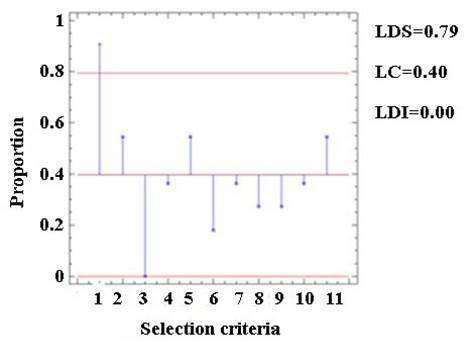 Legend: 1 = Performance; 2 = Vigor; 3 = yellow tuber; 4 = red tuber; 5 = Oval tubers; 6 = Erect plant; 7 = resistance; 8 = Earliness; 9 = Number of tubers; 10 = Large size uniformity of tubers; 11 = Appearance of tubers
Legend: 1 = Performance; 2 = Vigor; 3 = yellow tuber; 4 = red tuber; 5 = Oval tubers; 6 = Erect plant; 7 = resistance; 8 = Earliness; 9 = Number of tubers; 10 = Large size uniformity of tubers; 11 = Appearance of tubersFigure 4 Representation of the analysis of proportions of the different selection criteria by women
The criteria vigor, resistance and large size of the tubers reflected importance for presenting their values between the mean (LC) and LDI, while the criteria of yellow and red tubercle, precocity, tuber number and appearance were not essential for men because their low values were found between LC and LDI (Figure 5). These results infer that women and men have different criteria and preferences when selecting potato cultivars.
 Legend: 1 = Performance; 2 = Vigor; 3 = yellow tuber; 4 = red tuber; 5 = Oval tubers; 6 = Erect plant; 7 = resistance; 8 = Earliness; 9 = Number of tubers; 10 = Large size uniformity of tubers; 11 = Appearance of tubers
Legend: 1 = Performance; 2 = Vigor; 3 = yellow tuber; 4 = red tuber; 5 = Oval tubers; 6 = Erect plant; 7 = resistance; 8 = Earliness; 9 = Number of tubers; 10 = Large size uniformity of tubers; 11 = Appearance of tubersFigure 5 Representation of the analysis of proportions of the different selection criteria by men
Figure 6 shows the percentages of cultivars selected by both women and men, the cultivars most selected by women were “Atlas”, “Aurea”, “Faluka” and “Manitou”, while men selected more to “Touareg”, “Red Scarlett”, “Arizona” and “Faluka”, the latter selected by both. However, there were cultivars selected by women and not by men, such as “Red Magic”, “Amany”, “Tornado” and “Cimega”, and there were also cultivars selected by men and not by women such as they were “Daifla”, “Toureg” and “Margarita”. This result could be determined by the different tastes and criteria handled in the selection by women and by men.
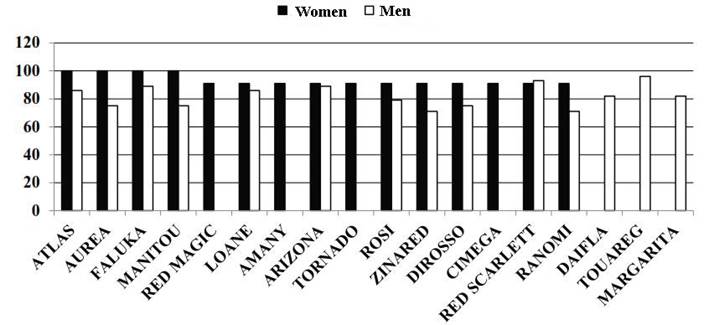
Figure 6 Percentage of potato cultivars most selected by women and by men in the E.C.V. “Horquita” in Cienfuegos
Evaluation of quantitative characters
Table 2 presents the fundamental statistics registered in INCA for the total number of tubers, the yield in t ha-1, the average tuber mass and S.s. Diversity was observed for the four evaluated characters. The number of tubers character reached values between 1.7 and 9.7 tubers per seedling, which justifies diversity for this character, as well as the yield were the most variable characters. In the latter, a high difference was found between the maximum and minimum values (7.20 and 46.56 t ha-1), which shows a great diversity for these two characters with coefficients of variation of 48.3 and 206.7 % respectively. The average mass showed the lowest coefficient of variation (7.9 %) although its minimum and maximum values were between 0.054 and 0.191 kg and the evaluation of Ss involvement recorded values between 1 and 4 degrees of involvement in the tubers with a coefficient variation of 22.9 %.
Table 2 Descriptive statistics of quantitative characters at INCA
| Characters | Minimum | Maximum | Mean | Standard error | Variance | CV (%) |
| NTtb | 1.7 | 9.7 | 4.9 | 0.090 | 2.365 | 48.3 |
| Yield | 7.20 | 46.56 | 27.36 | 0.442 | 56.58 | 206.7 |
| MP (Kg) | 0.054 | 0.191 | 0.126 | 0.001 | 0.010 | 7.9 |
| 1.0 | 4.0 | 1.7 | 0.036 | 0.390 | 22.9 |
NTtb = number of tubers per plant, Yield = yield t ha-1, MP = Average tuber mass, Ss = Streptomyces scabies tuber involvement, CV = Variation coefficient (%)
Figure 7 shows the 18 cultivars selected for achieving the highest yields in INCA, a selection criterion taken by the potato genetic improvement program, taking precisely into account the survey carried out with female and male collaborators in participatory selection. The cultivar “Manitou” registered the highest yield with 41.1 t ha-1, while “Metro” had the lowest yield (32.8 t ha-1) among these selected cultivars.
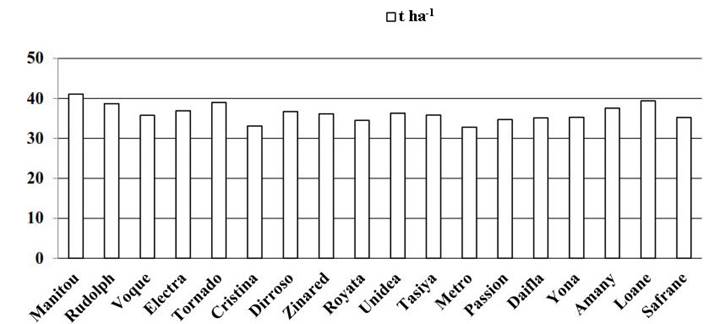
Figure 7 Representation of the average yield per hectare of selected cultivars in the Potato Genetic Improvement Program at INCA
Figure 8 represents the number of tubers per plant of the 18 cultivars selected at INCA. The cultivar with the highest value was “Taisiya” with 8.3 tubers per plant, while “Vogue” was the cultivar with the lowest value with 4.3.
Despite the fact that these cultivars were the most selected, a difference was found between the lowest and the highest result value that could be linked to the fact that this criterion was not very important in participatory selection as shown in Figuras 4 and 5.
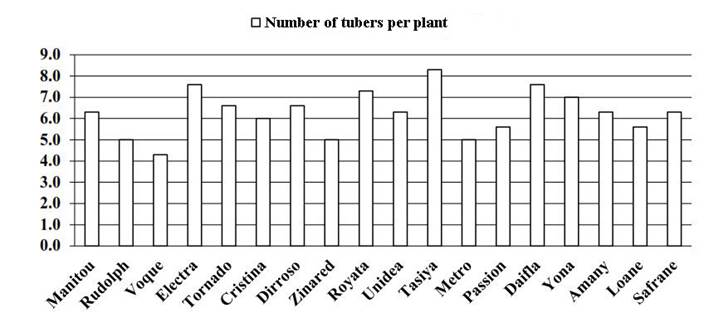
Figure 8 Representation of the average number of tubers per plant of selected cultivars in the Potato Genetic Improvement Program at INCA
Table 3 shows the fundamental statisticians registered in the E.A. Cienfuegos “Horquita” for the total number of tubers, the yield in t ha-1 and the average mass of tubers. Diversity was observed for the three evaluated characters. The character number of tubers per seedling reached a marked difference in values between the minimum and the maximum, which justifies diversity for this character with a coefficient of variation of 87.1 %, just as the yield was the most variable characters. In the latter, marked values were found between the maximum and minimum, which shows a diversity with a coefficient of variation of 206.6 %. The average mass showed the lowest coefficient of variation (8.1 %) although its minimum and maximum values were different from each other.
Table 3 Descriptive statistics of quantitative characters in the E.C.V. “Horquita” in Cienfuegos
| Characters | Minimum | Maximum | Mean | Standard error | Variance | CV (%) |
| NTtb | 2.4 | 17.4 | 6.68 | 0.280 | 5.82 | 87.1 |
| Yield | 18.67 | 52.00 | 34.51 | 0.967 | 69.26 | 200.6 |
| MP | 0.067 | 0.213 | 0.123 | 0.003 | 0.010 | 8.1 |
NTtb = number of tubers per plant, Yield = yield t ha-1, MP = Average tuber mass (Kg), CV = Coefficient of variation (%)
Figure 9 shows the cultivars with the highest yields in the E.C.V. “Horquita” in Cienfuegos. The cultivar that reached the highest yield was “BIC-05-9” with 51.6 t ha-1 and the lowest yield was registered in “Melanto” and “Manitou” with 40 t ha-1.
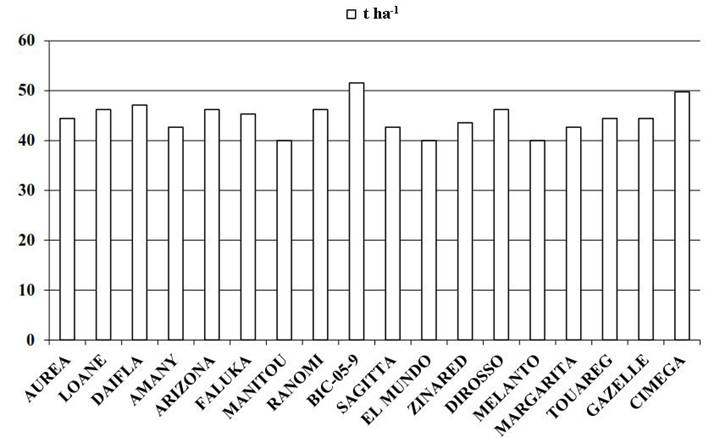
Figure 9 Representation of the mean of the highest yields per hectare of the selected cultivars in the E.A. “Horquita” in Cienfuegos
Table 4 shows the fundamental statisticians registered in the “El Violento” farm (Mayabeque province) for the total number of tubers, the yield in t ha-1 and the average mass of the tubers. Diversity was observed for the three evaluated characters, the number of tubers character reached a difference of values between the minimum and the maximum, which justifies diversity for this character with a variation coefficient of 32.7 %, as well as the yield were the most variable characters. In the latter, the maximum and minimum values were found with some important difference, which shows a diversity with a coefficient of variation of 173.8 %. The average mass showed the lowest coefficient of variation (6.2 %) with its minimum values of 0.148 and maximum of 0.163 kg.
The differentiation of means allowed differentiated behaviors to be identified among cultivars, which could be used in a genetic improvement program or selected for commercial production, coinciding with that recommended in the study of genotype x environment interaction in potatoes using the AMMI methodology to the identification of stable genotypes and adapted to specific localities 14.
The results coincide with those found by several authors 15,16, who determined the great contrasts of yields and number of tubers in different environments and potato cultivars in Bhutan when they used the “Mom-Baby” methodology and in Colombia when studying the interaction with univariate and multivariate methods.
Table 4 Descriptive statistics of quantitative characters in the farm “El Violento” in Mayabeque
| Characters | Minimum | Maximum | Mean | Standard error | Variance | CV (%) |
| NTtb | 2.8 | 9.3 | 6.6 | 0.185 | 2.160 | 32.7 |
| Yield | 20.00 | 68.15 | 47.96 | 1.371 | 118.49 | 173.8 |
| MP | 0.148 | 0.167 | 0.161 | 0.004 | 0.010 | 6.2 |
NTtb = number of tubers per plant, Yield = yield t ha-1, MP = Average tuber mass (Kg), CV = Coefficient of variation (%)
Figure 10 shows the cultivars that achieved the highest yields in the Finca “El Violento” Mayabeque province. The cultivar that achieved the highest yield was “Touareg” with 68.1 t ha-1 followed by the cultivar “Spunta” with 67.4 t ha-1 and the cultivars “Passion”, “Gazelle” and “Red Bull” with 66, 7 t ha-1 and the lowest yield was registered in “Rosi” with 54.8 tha-1.

Figure 10 Representation of the average of the highest yields per hectare of the selected cultivars in the “El Violento” farm in Mayabeque
Table 5 shows the fundamental statisticians registered in the E.C.V. “La Cuba” (Ciego de Ávila Province) of the total number of tubers (NTtb), the yield in t ha-1 (Yield) and the average mass (MP) of the tubers. Diversity was observed for the three evaluated characters, the number of tubers character reached a high difference of values between 2.4 and 15.3 tubers per seedling, which justifies a great diversity for this character with a coefficient of variation of 99.4 %. Also, the performance were the most variable characters, in the latter the maximum and minimum values were found between 5.6 and 60.2 t ha-1, which shows a high diversity with a coefficient of variation of 162.0 %. The average tuber mass showed the lowest coefficient of variation (8.7 %) despite showing a significant difference between its minimum and maximum values of 0.021 and 0.239 kg respectively.
Table 5 Descriptive statistics of quantitative characters in the E.C.V La Cuba in Ciego de Ávila
| Characters | Minimum | Maximum | Mean | Standard error | Variance | CV (%) |
| NTtb | 2.4 | 15.6 | 6.6 | 0.304 | 6.566 | 99.4 |
| Yield | 5.6 | 60.2 | 32.45 | 1.465 | 52.58 | 162.0 |
| MP | 0.021 | 0.239 | 0.114 | 0.004 | 0.010 | 8.7 |
NTtb = number of tubers per plant, Yield = yield t ha-1, MP = Average tuber mass (Kg) figur, CV = Coefficient of variation (%)
Figure 11 records the cultivars that achieved the highest yields in the E.C.V. “La Cuba”. The cultivar that achieved the highest yield was “Melanto” with 60.3 t ha-1 followed by the cultivar “Touareg” with 59.6 t ha-1 and the cultivars “Unidea”, “Royata KWS” and “Zinared” were the of lower yields with 43.4 t ha-1 and the last two with 44.5 tha-1.
CONCLUSIONS
At least 41 of the 74 potato cultivars received the highest votes by farmers, technicians and breeders; With the MB design it allowed to select 15: “Loane”, “Amany”, “Zinared”, “Dirosso”, “Tornado”, “Daifla”, “Touareg”, “Atlas”, “Manitou”, “Arizona”, “Cimega”, “Margarita”, “Rudolph”, “Melanto” and “Faluka” considering the correspondence of their behavior in general in the different tests.
Considering men and women in the selection revealed valuable but different experiences, perceptions and knowledge, which involve gender specific roles, therefore, different selection criteria.
Potato cultivars indicate a diversity of qualitative and quantitative characters recorded in different localities, which could indicate different responses or degrees of adaptation of these cultivars in these trials.
Within the Cuban Genetic Improvement Program, the Mom-Baby methodology could be used as one more tool for the selection of potato cultivars appropriate to the environments of the producers. On the other hand, the selection criteria of the men and women registered in this document must be taken into account in the Cuban Potato Genetic Improvement Program for the selection of parents of genetic and agronomic interest.
BIBLIOGRAFÍA
1. De Haan S, Salas E, Fonseca C, Gastelo M, Amaya N, Bastos C, et al. Selección participativa de variedades de papa (SPV) usando el diseño mamá y bebé: una guía para capacitadores con perspectiva de género. CIP: Lima. 2017;82. [ Links ]
2. Cuesta X, Unda J, Yanez Z. Potato preferences in the Ecuadorian Highland. Abstrac Book 10 th WPC-ALAP 2018. Instituto Nacional de Innovación Agraria-INIA: Perú, Cusco. 2017. p. 70. [ Links ]
3. De la Fe C, Castillo JG, Salomón JL, Caballero A, Lorenzo N. La selección participativa de variedades (SPV) en el cultivo de la papa. Cultivos Tropicales. 2007;28(3):77-82. [ Links ]
4. Wangchuk P, De Haan S, Dochen R. Participatory Varietal Selection using Mother and Baby Trial Design in Potato. Department of Agriculture Ministry of Agriculture and Forests: Thimpu, Bhutan. 2015; [ Links ]
5. NIVAA. Catálogo Holandés sobre la patata. Wageningen. 2015. [ Links ]
6. Hernández J, Pérez J, Bosch I, Castro SN. Clasificación de los suelos de Cuba. Ediciones INCA: Cuba. 2015. 93 p. [ Links ]
7. MINAG. Instructivo técnico para la producción de papa en Cuba. La Habana: MINAG. 2017 p. 59. [ Links ]
8. INIA. Descriptores mínimos de papa (Solanum8. sp.) para su inscripción en el Registro Nacional de la Papa Nativa Peruana (RNPNP). Resolución No 247/11/INIA. Instituto Nacional de Innovación Agraria. Ministerio de Agricultura y Riego: Lima-Perú. 2016. [ Links ]
9. Beukema HP, Peeten J, Turkensteen L. Potato explorer: production, seed, varieties, diseases, storage, markets. NIVAP. 2004. [ Links ]
10. IBM Corporation. IBM SPSS Statistics [en línea]. Versión 15.0.1, [Windows], U.S, 2006. [ Links ]
11. Mosquera GV, Mendoza ZH, Villagómez CV, Tay D, Gómez R. Herencia del color de pulpa en papas nativas diploides. 2016. [ Links ]
12. Struik PC, Van der Putten PEL, Caldiz DO, Scholte K. Response of stored potato seed tubers from contrasting cultivars to accumulated day-degrees. Crop Science. 2006;46(3):1156-68. [ Links ]
13. Ortiz R, Golmirzaie AM. Genetic parameters for agronomic characteristics. I. Early and intermediate breeding populations of true potato seed. Hereditas. 2003;139(3):212-6. [ Links ]
14. Varela M, Castillo JG, Estévez A, Vicente JL, Galindo P, Blázquez A. Una generalización de los modelos AMMI basada en el algoritmo de TUCKALS3 para el análisis de componentes principales de tres modos. Cultivos Tropicales. 2008;29(1):69-72. [ Links ]
15. Bajgai Y, Dochen T, Wangchuk P, Kadian M, Felde T. Potato varietal evaluation and release of nutrient-dense potato variety in Bhutan. Abstract Book 10th WPC-ALAP 2018. Instituto Nacional de Innovación Agraria-INIA: Perú, Cusco. 2017. p. 107-8. [ Links ]
16. Urquijo JS, Darghan A, Rodriguez LE. Parametric stability and genotype by environment interaction analyses for tuber yield and specific gravity in diploid potato (Solanum tuberosum16. Group Phureja16. ). In: Abstract Book 10th WPC-ALAP 2018 Congress: Biod. 2017. [ Links ]
Received: August 08, 2018; Accepted: June 01, 2020











 text in
text in 

